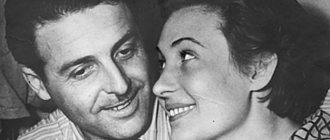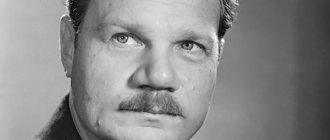Biography
There are few people in the world who do not know for what merits Mikhail Illarionovich received laurels of honor. Not only Alexander Sergeevich Pushkin sang the praises of this brave man, but also Derzhavin, Zhukovsky and other literary geniuses. The field marshal, as if possessing the gift of foresight, won a crushing victory in the Battle of Borodino, saving the Russian Empire from the plans of Napoleon Bonaparte.
Childhood and youth
September 5 (16), 1747 in the cultural capital of Russia, the city of St. Petersburg, with Lieutenant General Illarion Matveevich Golenishchev-Kutuzov and his wife Anna Illarionovna, who, according to documents, came from the family of the retired captain Bedrinsky (according to other information - the ancestors of the woman were noblemen Beklemishev), a son was born, named Mikhail.
Portrait of Mikhail Kutuzov
However, there is an opinion that the lieutenant had two sons. The second son's name was Semyon; he allegedly managed to receive the rank of major, but due to the fact that he lost his mind, he was under the care of his parents for the rest of his life. Scientists made this assumption because of a letter written by Mikhail to his beloved in 1804. In this manuscript, the field marshal said that upon arriving at his brother, he found him in his previous condition.
“He talked a lot about the pipe and asked me to save him from this misfortune and got angry when he began to tell him that there was no such pipe,” Mikhail Illarionovich shared with his wife.
The father of the great commander, who was a comrade-in-arms of Alexander Vasilyevich Suvorov, began his career under Peter the Great. After graduating from a military engineering educational institution, he began to serve in the engineering troops. For his exceptional intelligence and erudition, contemporaries called Illarion Matveyevich a walking encyclopedia or a “reasonable book.”
Mikhail Kutuzov in his youth
Of course, the field marshal’s parent made a contribution to the development of the Russian Empire. For example, even under Elizaveta Petrovna, Kutuzov Sr. compiled a model of the Catherine Canal, which is now called the Griboyedov Canal.
Thanks to the project of Illarion Matveevich, the consequences of the flood of the Neva River were prevented. Kutuzov's plan was carried out during the reign of Catherine II. As a reward, Mikhail Illarionovich's father received a golden snuffbox decorated with precious stones as a gift from the ruler.
Monument to Mikhail Kutuzov in Moscow
Illarion Matveevich also took part in the Turkish War, which lasted from 1768 to 1774. From the side of the Russian troops, Alexander Suvorov and commander Count Pyotr Rumyantsev commanded. It is worth saying that Kutuzov Sr. distinguished himself on the battlefield and gained a reputation as a person knowledgeable in both military and civil affairs.
Mikhail Kutuzov's future was predetermined by his parents, because after the young man finished home schooling, in 1759 he was sent to the Artillery and Engineering Noble School, where he showed extraordinary abilities and quickly moved up the career ladder. However, one should not exclude the efforts of his father, who taught artillery sciences at this institution.
Field Marshal Mikhail Kutuzov
Among other things, since 1758 in this noble school, which now bears the name of the Military Space Academy named after. A.F. Mozhaisky, lectured on physics by the encyclopedist scientist Mikhail Vasilyevich Lomonosov. It is worth noting that the talented Kutuzov graduated from the academy as an external student: the young man, thanks to his extraordinary mind, spent a year and a half on the school bench instead of the required three years.
Kutuzov and Napoleon
In 1804, the Russian Empire became a member of the coalition against France. In 1805, Kutuzov was put in command of one of the armies that were sent to Austria. He did not have time to unite with his ally, but, thanks to a strategic maneuver, he managed to avoid encirclement of his troops. Kutuzov did not want to go on a retaliatory offensive, but at the behest of the heads of state he entered the battle of Austerlitz in 1805, which ended in a grandiose defeat.
Lance Armstrong biography of cyclist
Rice. 4. Portrait of M. I. Kutuzov in the uniform of a colonel of the Lugansk pikemen regiment. Around 1777
Military service
In February 1761, the future field marshal was awarded a matriculation certificate, but remained at the school because Mikhail (with the rank of ensign engineer), on the advice of Count Shuvalov, began teaching mathematics to the academy students. Next, the capable young man became the aide-de-camp of Duke Peter August of Holstein-Beck, managed his office and showed himself to be a diligent worker. Then, in 1762, Mikhail Illarionovich rose to the rank of captain.
Mikhail Kutuzov
In the same year, Kutuzov became close to Suvorov because he was appointed company commander of the Astrakhan 12th Grenadier Regiment, which at that time was commanded by Alexander Vasilyevich. By the way, Pyotr Ivanovich Bagration, Prokopiy Vasilyevich Meshchersky, Pavel Artemyevich Levashev and other famous personalities once served in this regiment.
In 1764, Mikhail Illarionovich Kutuzov was in Poland and commanded small troops against the Bar Confederation, which in turn opposed the comrades of the Polish king Stanislav August Poniatowski, a supporter of the Russian Empire. Thanks to his innate talent, Kutuzov created victorious strategies, made rapid forced marches and defeated the Polish Confederates, despite a small army, inferior in number to the enemy.
Commander Mikhail Kutuzov
Three years later, in 1767, Kutuzov joined the ranks of the Commission for the drafting of a new Code - a temporary collegial body in Russia, which was engaged in developing the systematization of the codes of laws that took place after Tsar Alexei Mikhailovich adopted the Council Code (1649). Most likely, Mikhail Illarionovich was brought to the board as a secretary-translator, because he was fluent in French and German, and also spoke fluent Latin.
Mikhail Kutuzov and his army
The Russian-Turkish wars of 1768–1774 are a significant milestone in the biography of Mikhail Illarionovich. Thanks to the conflict between the Russian and Ottoman empires, Kutuzov gained combat experience and proved himself to be an outstanding military leader. In July 1774, the son of Illarion Matveyevich, commander of a regiment intended to storm enemy fortifications, was wounded in a battle against the Turkish landing in the Crimea, but miraculously survived. The fact is that the enemy bullet pierced the commander’s left temple and exited near his right eye.
Mikhail Kutuzov at the military council
Fortunately, Kutuzov’s vision was preserved, but his “squinting” eye reminded the field marshal all his life of the bloody events of the operation of the Ottoman troops and navy. In the fall of 1784, Mikhail Illarionovich was awarded the primary military rank of major general, and also distinguished himself in the Battle of Kinburn (1787), the capture of Izmail (1790, for which he received the military rank of lieutenant general and was awarded the Order of George, 2nd degree), showed courage in the Russian-Polish War (1792), the War with Napoleon (1805) and other battles.
Military career
In 1761, Kutuzov was given a certificate, but he remained within the walls of the educational institution, as he began teaching mathematics. Then the talented young man becomes the adjutant of Prince Peter of Holstein-Beck, he manages the office, the maintenance of his property and shows himself as a good worker. In 1762, Kutuzov received the rank of captain.
In the same year, he becomes close to Suvorov, as he is appointed commander of a company of the Astrakhan Grenadier Regiment. The following great men once served in this unit:
- Pavel Levashov;
- Procopius of Meshchersky;
- Peter Bagration.
In 1765, Kutuzov was in Poland and commanded troops opposing the Bar Confederation, which was fighting the allies of the Polish king Stanislav Poniatowski, a supporter of the Russian Empire. The Russian commander developed victorious tactics, organized forced marches and defeated the Polish confederation, despite the small army, which was inferior in number of soldiers to the enemy.
In 1767, he became a member of the board for the creation of a new code - a temporary collegial Russian body engaged in systematization of legislative codes that remained after the adoption of the Council Code by Emperor Alexei the First.
Russian-Turkish wars 1768-1774. - an important period for Kutuzov. In this conflict, the commander gained combat experience and showed himself to be a talented military leader. In 1774, he was wounded in a battle with the Turks in Crimea, but remained alive. The bullet pierced the temple and exited near the right eye.
The commander’s vision was preserved, but the “slanting” eye reminded him of the terrible events of that time until the end of his life. In the fall of 1784, Kutuzov was awarded the rank of major general, and in 1790 he was awarded the rank of lieutenant general for the capture of Izmail. During his career he receives many awards:
- Order of St. Vladimir 2nd degree - for the creation of the Bug Corps.
- Order of St. Anna - for the battle of Ochakov.
- Order of St. John.
- Order of Alexander Nevsky - for the battles of Babadag.
- Order of St. Vladimir 1st degree - for the battle with the French in 1806.
- Order of St. Andrew the First-Called.
- Golden sword with precious stones - for the Battle of Tarutino.
- Portrait of Tsar Alexander the First with diamonds.
War of 1812
The genius of Russian literature Lev Nikolayevich Tolstoy could not ignore the bloody events of 1812, which left a mark on history and changed the fate of the countries participating in the Patriotic War - France and the Russian Empire. Moreover, in his epic novel “War and Peace,” the author of the book tried to scrupulously describe both the battles and the image of the leader of the people, Mikhail Illarionovich Kutuzov, who in the work took care of the soldiers as if they were children.
Mikhail Kutuzov during the War of 1812
The reason for the confrontation between the two powers was the refusal of the Russian Empire to support the continental blockade of Great Britain, despite the fact that the Peace of Tilsit (in force since July 7, 1807) was concluded between Alexander I and Napoleon Bonaparte, according to which the son of Paul I undertook to join the blockade. This agreement turned out to be unfavorable for Russia, which had to abandon its main business partner.
During the war, Mikhail Illarionovich Kutuzov was appointed commander-in-chief of the Russian armies and militias, and thanks to his merits, he was awarded the title of His Serene Highness, which raised the morale of the Russian people, because Kutuzov acquired a reputation as an undefeated commander. However, Mikhail Illarionovich himself did not believe in a grandiose victory and used to say that Napoleon’s army could be defeated only through deception.
battle of Borodino
Initially, Mikhail Illarionovich, like his predecessor Barclay de Tolly, chose a policy of retreat, hoping to exhaust the enemy and gain support. But Alexander I was dissatisfied with Kutuzov’s strategy and insisted that Napoleon’s army not reach the capital. Therefore, Mikhail Illarionovich had to give a general battle. Despite the fact that the French outnumbered and outgunned Kutuzov's army, the field marshal managed to defeat Napoleon in the Battle of Borodino in 1812.
Kutuzov Mikhail Illarionovich
During the Great Patriotic War, the Order of Kutuzov I, II (July 29, 1942) and III (February 8, 1943) degrees was established in the USSR. It was awarded to about 7 thousand people and entire military units. In modern Russia there is also the Order of Kutuzov, in a similar design, but in the same degree.
One of the cruisers of the USSR Navy was named in honor of M.I. Kutuzov.
Asteroid 2492 Kutuzov is named after M.I. Kutuzov.
A. S. Pushkin in 1831 dedicated the poem “Before the Saint’s Tomb” to the commander, writing it in a letter to Kutuzov’s daughter Elizaveta. In honor of Kutuzov, G. R. Derzhavin, V. A. Zhukovsky and other poets wrote poems.
The famous fabulist I. A. Krylov, during the life of the commander, composed the fable “The Wolf in the Kennel,” where he depicted Kutuzov’s struggle with Napoleon in an allegorical form.
In Moscow there is Kutuzovsky Prospekt (laid in 1957-1963, included Novodorogomilovskaya Street, part of Mozhaiskoye Highway and Kutuzovskaya Sloboda Street), Kutuzovsky Lane and Kutuzovsky Proezd (named in 1912), Kutuzovo station (opened in 1908) of the Moscow District railway, metro station "Kutuzovskaya" (opened in 1958), Kutuzov Street (preserved from the former city of Kuntsev).
In St. Petersburg there is Kutuzov Embankment (named in 1945), on which there is house 30, which belonged to the Kutuzov family at the beginning of the 19th century (at that time it was part of the Palace Embankment).
In many cities of Russia, as well as in other former republics of the USSR (for example, in the Ukrainian Izmail, Moldavian Tiraspol) there are streets named in honor of M. I. Kutuzov.
Since February 2020, one of the control rooms of the National Defense Control Center of the Russian Federation has been named after Field Marshal M.I. Kutuzov.
Monuments:
In memory of the glorious victories of Russian weapons over the army of Napoleon, monuments were erected to M. I. Kutuzov:
1815 - in Bunzlau, on the orders of the King of Prussia.
1824 - Kutuzov Fountain - a fountain-monument to M.I. Kutuzov, located near Alushta, near the place where Kutuzov was wounded (the village of Shumy), during the repulsion of the Turkish landing. The fountain was originally built in 1804 with the permission of the Tauride governor D.B. Mertvago, the son of the Turkish officer Ismail-Aga, who died in the Battle of Shumsky, in memory of his father. Renamed Kutuzovsky during the construction of the road on the Southern Coast of Crimea (1824-1826) in memory of the victory of Russian troops in the last battle of the Russian-Turkish war of 1768-1774.
1837 - monument to Kutuzov and Barclay de Tolly in St. Petersburg, in front of the Kazan Cathedral, sculptor B. I. Orlovsky.
1862 - in Veliky Novgorod on the Monument “1000th Anniversary of Russia”, among the 129 figures of the most outstanding personalities in Russian history, there is the figure of M. I. Kutuzov.
1912 - obelisk on the Borodino field, near the village of Gorki, architect P. A. Vorontsov-Velyamov.
1953 - in Kaliningrad, sculptor Y. Lukashevich (in 1997 moved to Pravdinsk (formerly Friedland), Kaliningrad region); in 1995, a new monument to M. I. Kutuzov by sculptor M. Anikushin was erected in Kaliningrad.
1954 - in Smolensk, at the foot of the Cathedral Hill; authors: sculptor G. I. Motovilov, architect L. M. Polyakov.
1964 - in the rural settlement of Borodino near the State Borodino Military-Historical Museum-Reserve; author: sculptor N.V. Tomsky.
1973 - in Moscow near the Battle of Borodino panorama museum, sculptor - N.V. Tomsky.
1987 - bust in Maloyaroslavets near the Monument to the Heroes of the Battle of 1812 and the Military History Museum of 1812; sculptor - S. I. Gerasimenko.
1997 - in Tiraspol, on Borodino Square in front of the House of Officers of the Russian Army.
2009 - in Bendery, on the territory of the Bendery fortress, in the capture of which Kutuzov took part in 1770 and 1789.
2012 - in Krasnaya Pakhra, where the headquarters of M.I. Kutuzov was located (to the 200th anniversary of the victory in the Patriotic War of 1812).
A small monument to Kutuzov was erected in 1959 in the town of Khoroshev (Zhitomir region, Ukraine), where Kutuzov’s estate was located. The ancient park in which the monument is located also bears the name of M. I. Kutuzov.
2012 - a bust of Field Marshal Mikhail Kutuzov was installed in Novosibirsk near the garrison Officers' House.
There is a small monument to Kutuzov in the city of Brody. Lviv region Ukraine, during Euromaidan it was, by decision of the local city council, dismantled and moved to a utility yard.
Memorial plaques
2012 - a memorial plaque to M. I. Kutuzov (Governor General of Kyiv 1806-1810) was installed in Kyiv.
In literature
Novel “War and Peace” - author L. N. Tolstoy Novel “Kutuzov” (1960) - author L. I. Rakovsky
In numismatics
In 2012, the Central Bank of the Russian Federation issued a coin (2 rubles, steel with nickel galvanic coating) from the series “Commanders and Heroes of the Patriotic War of 1812” with a portrait of Field Marshal Kutuzov on the reverse.
In 2012, the Central Bank of the Russian Federation issued a gold coin of 50 rubles from the series “200th anniversary of the victory of Russia in the Patriotic War of 1812” with a portrait of Field Marshal Kutuzov on the reverse.
In philately
Artimarks of the Stargorod Zemstvo, 1912 Postage stamp of the USSR, 1962 First day envelope dedicated to the 220th anniversary of the exchange of ambassadors on the Dniester
Film incarnations
Perhaps the most “textbook” image of Kutuzov on the silver screen was created by Igor Ilyinsky in Eldar Ryazanov’s film “The Hussar Ballad,” filmed for the 150th anniversary of the Patriotic War of 1812. As a result, it was widely believed that Kutuzov wore a patch over his right eye, although this was not the case.
Kutuzov was played by the following actors:
Gennady Novikov (“War and Peace”, Russian Empire, 1915). Alexey Dikiy (“Kutuzov”, USSR, 1943). Oscar Homolka (War and Peace, USA-Italy, 1956). Polikarp Pavlov (“Battle of Austerlitz”, France-Italy-Yugoslavia, 1960). Igor Ilyinsky (“Hussar Ballad”, USSR, 1962). Boris Zakhava (“War and Peace”, USSR, 1967). Frank Middlemass (“War and Peace (English) Russian,” Great Britain, 1972). Evgeny Lebedev (“Squadron of Flying Hussars”, USSR, 1980). Mikhail Kuznetsov (“Bagration”, USSR, 1985). Dmitry Suponin (“Adjutants of Love”, Russia, 2005). Alexander Novikov (“Favorite”, 2005). Vladimir Ilyin (“War and Peace”, Russia-France-Germany-Italy-Poland, 2007). Vladimir Simonov (“Rzhevsky against Napoleon”, Russia-Ukraine, 2012). Sergey Zhuravel (“Ulan Ballad”, Russia, 2012). Vladimir Matveev (“Vasilisa”, Russia, 2014). Brian Cox (War and Peace, UK, 2016).
Personal life
According to rumors, the commander’s first lover was a certain Ulyana Alexandrovich, who came from the family of the Little Russian nobleman Ivan Alexandrovich. Kutuzov met this family as a little-known young man with a low rank.
Mikhail Kutuzov's wife in her youth
Mikhail began to often visit Ivan Ilyich in Velikaya Krucha and one day he took a fancy to a friend’s daughter, who responded with mutual sympathy. Mikhail and Ulyana began dating, but the lovers did not tell their parents about their affection. It is known that at the time of their relationship the girl fell ill with a dangerous disease for which no medicine could help.
Ulyana's desperate mother swore that if her daughter recovered, she would definitely pay for her salvation - she would never get married. Thus, the parent, who delivered an ultimatum to the girl’s fate, doomed the beauty to the crown of celibacy. Ulyana recovered, but her love for Kutuzov only increased; they say that the young people even set a wedding day.
Portrait of Ekaterina Ilyinichna Golenishcheva-Kutuzova
However, a few days before the celebration, the girl fell ill with a fever and, fearing God’s will, rejected her lover. Kutuzov no longer insisted on marriage: the lovers parted ways. But the legend says that Alexandrovich did not forget Mikhail Illarionovich and prayed for him until the end of her years.
It is reliably known that in 1778 Mikhail Kutuzov proposed marriage to Ekaterina Ilyinichna Bibikova and the girl agreed. The marriage produced six children, but the first-born Nikolai died in infancy from smallpox.
Ekaterina Kutuzova in old age
Catherine loved literature, theaters and social events. Kutuzov’s beloved spent more money than she could afford, so she repeatedly received reprimands from her husband. Also, this lady was very original; contemporaries said that already in old age, Ekaterina Ilyinichna dressed like a young lady.
It is noteworthy that little Vanya Turgenev, the future great writer who invented the nihilist hero Bazarov, managed to meet Kutuzov’s wife. But because of her eccentric outfit, the elderly lady, whom Turgenev’s parents revered, made an ambiguous impression on the boy. Vanya, unable to withstand his emotions, said:
“You look just like a monkey.”
Death
In April 1813, Mikhail Illarionovich caught a cold and went to the hospital in the town of Bunzlau. According to legend, Alexander I arrived at the hospital to say goodbye to the field marshal, but scientists have refuted this information. Mikhail Illarionovich died on April 16 (28), 1813. After the tragic event, the field marshal's body was embalmed and sent to the city on the Neva. The funeral took place only on June 13 (25). The tomb of the great commander is located in the Kazan Cathedral in the city of St. Petersburg.
Funeral of Mikhail Kutuzov
In memory of the talented military leader, feature films and documentaries were made, monuments were erected in many Russian cities, and a cruiser and a motor ship were named after Kutuzov. Among other things, in Moscow there is the Kutuzov Izba museum, dedicated to the military council in Fili on September 1 (13), 1812.
Death of a Commander
In the spring of 1813, Kutuzov caught a cold and was hospitalized in the city of Bunzlau. According to legend, Alexander the First came to the hospital to say goodbye to the commander, but historians have not proven this fact. Mikhail Illarionovich died on April 16, 1813. After this, Kutuzov’s body was embalmed and sent to St. Petersburg. The funeral took place only on June 13. His grave is located in the Kazan Cathedral.
A large number of films were made in memory of the commander, busts and monuments were erected in many cities, and several ships were named in his honor.
Interesting Facts
- In 1788, Kutuzov took part in the assault on Ochakov, where he was again wounded in the head. However, Mikhail Illarionovich managed to cheat death, because the bullet passed along the old path. Therefore, a year later, the strengthened commander fought near the Moldavian city of Causeni, and in 1790 he showed bravery and courage in the assault on Izmail.
- Kutuzov was a confidant of the favorite Platon Zubov, but to become an ally of the most influential person in the Russian Empire (after Catherine II), the field marshal had to work hard. Mikhail Illarionovich woke up an hour before Platon Alexandrovich woke up, made coffee and took this aromatic drink to Zubov’s bedchamber.
Cruiser Museum "Mikhail Kutuzov"
- Some are accustomed to imagining the appearance of a commander with a bandage over his right eye. But there is no official confirmation that Mikhail Illarionovich wore this accessory, especially since this bandage was hardly necessary. Associations with the pirate arose among history buffs after the release of Vladimir Petrov’s Soviet film “Kutuzov” (1943), where the commander appeared in the guise in which we are accustomed to seeing him.
- In 1772, a significant event occurred in the biography of the commander. While among his friends, 25-year-old Mikhail Kutuzov allowed himself a daring joke: he acted out an impromptu skit in which he mimicked the commander Pyotr Aleksandrovich Rumyantsev. Amid general guffaws, Kutuzov showed his colleagues the count's gait and even tried to copy his voice, but Rumyantsev himself did not appreciate such humor and sent the young soldier to another regiment under the command of Prince Vasily Dolgorukov.











